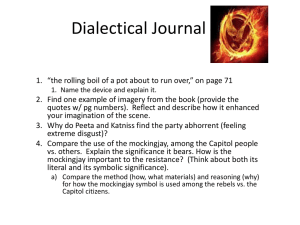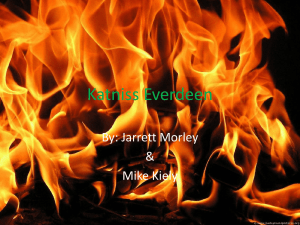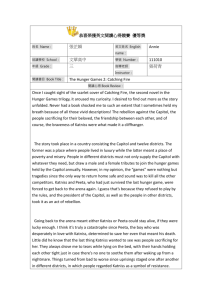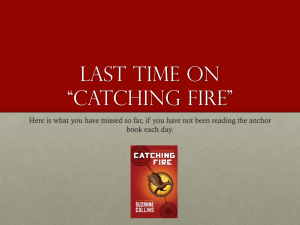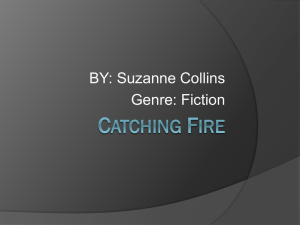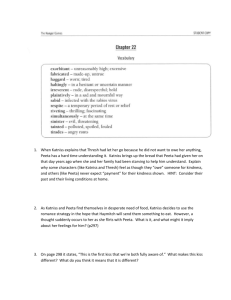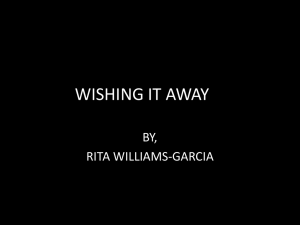DISCUSSION GUIDE
advertisement
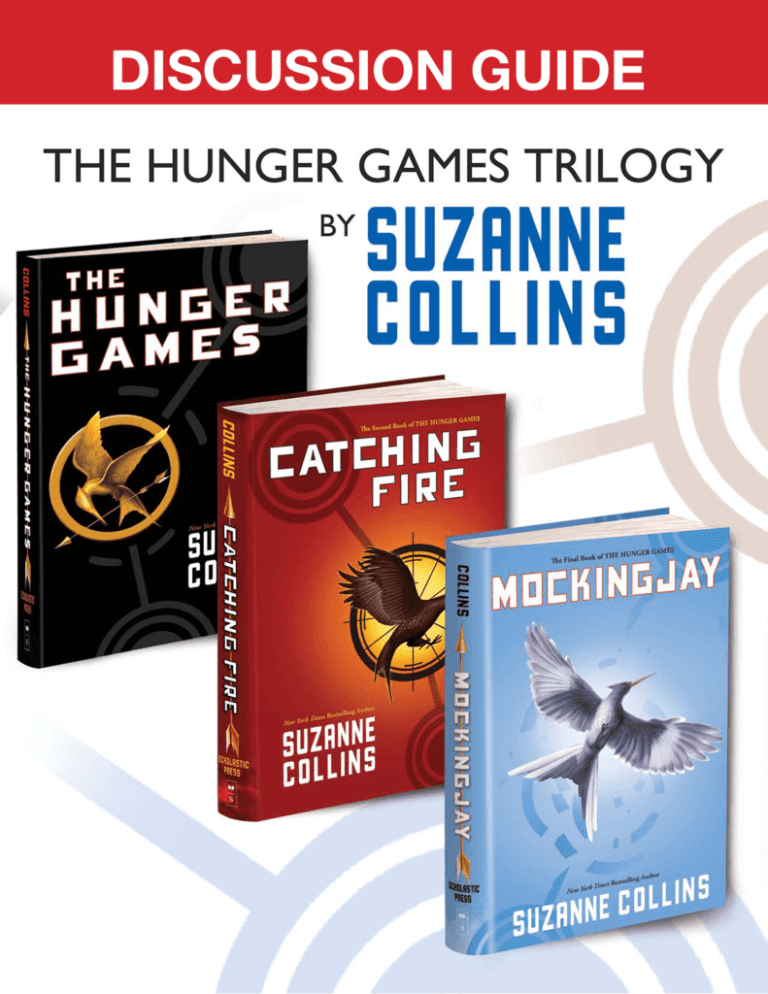
Discussion Guide About the HUNGER GAMES In this gripping young adult novel set in a future with unsettling parallels to our present, the nation of Panem consists of a shining Capitol surrounded by 12 outlying Districts, in the ruins of the area once known as North America. In this stratified society where the Capitol controls all resources, 16-year-old Katniss and her friend Gale forage for food in the woods surrounding their impoverished District. The main support for both their families, Katniss and Gale are apprehensive about the approaching annual Reaping, when two “tributes” between the ages of 12 and 18 will be chosen by lottery from each of the 12 districts to compete in The Hunger Games, a survival contest on live TV in which teenagers fight to the death. When her beloved younger sister Prim is chosen as one of the “tributes,” Katniss volunteers to go in her sister’s place. Her fellow tribute from District 12 is Peeta, a boy with whom she soon develops a complicated relationship. After traveling to the Capitol and undergoing elaborate training and preparation, Katniss and Peeta are launched into the Game. In the terrifying events that follow, Katniss must marshal all her skills to stay alive and all her emotions to remain a caring human being in the face of the stark brutality of the Games. “It’s hard to choose one element that inspired The Hunger Games,” says Suzanne Collins. “Probably the first seeds were planted when, as an eight-year-old with a mythology obsession, I read the story of Theseus. The myth told how in punishment for past deeds, Athens periodically had to send seven youths and seven maidens to Crete where they were thrown in the Labyrinth and devoured by the monstrous Minotaur. Even as a third grader, I could appreciate the ruthlessness of this message. ‘Mess with us and we’ll do something worse than kill you. We’ll kill your children.’ “Other early influences would have to include watching too many gladiator movies, which dramatized the Romans’ flair for turning executions into popular entertainment; my military specialist dad who took us to battlefields for family vacations; and touring with a sword fighting company in high school. But it wasn’t until the much more recent experience of channel surfing between reality TV programming and actual war coverage that the story for this series came to me.” Discussion Questions for The Hunger Games 1. H ow does Katniss feel about the country of Panem? Why does she need to make her face “an indifferent mask” and be careful what she says in public? 2. D escribe Katniss’s relationships with Gale, with Prim, and with her mother. How do those relationships define her personality? Why does she say about Peeta, “I feel like I owe him something, and I hate owing people”? How does her early encounter with Peeta affect their relationship after they are chosen as tributes? 3. H ow does the fact that the tributes are always on camera affect their behavior from the time they are chosen? Does it make it easier or harder for them to accept their fate? How are the “career tributes” different from the others? 4. Why are the “tributes” given stylists and dressed so elaborately for the opening ceremony? Does this ceremony remind you of events in our world, either past or present? Compare those ceremonies in real life to the one in the story. 5. When Peeta declares his love for Katniss in the interview, does he really mean it or did Haymitch create the “star-crossed lovers” story? What does Haymitch mean when he says, “It’s all a big show. It’s all how you’re perceived”? Why do they need to impress sponsors and what are those sponsors looking for when they are watching the Games? 6. B efore the Games start, Peeta tells Katniss,“. . . I want to die as myself . . . I don’t want them to change me in there.Turn me into some kind of monster that I’m not.”What does this tell you about Peeta? What does he fear more than death? Is he able to stay true to himself during the Games? 7. Why does Katniss ignore Haymitch’s advice to head directly away from the Cornucopia? Did she do the right thing to fight for equipment? What are the most important skills she has for staying alive? Her knowledge of nature? Her skill with a bow and arrow? Her trapping ability? What qualities of her personality keep her going? Her capacity for love? Her intelligence? Her self-control? 8. W hy does Peeta join with the Career Tributes in the beginning of the Games? What does he hope to gain? Why do they accept him when they start hunting as a group? Why do groups form in the beginning when they know only one of them will be able to survive? 9. W hat makes Katniss and Rue trust each other to become partners? What does Katniss gain from this friendship besides companionship? Is Katniss and Rue’s partnership formed for different reasons than the other groups’? 10. D iscuss the ways in which the Gamemakers control the environment and “entertainment” value of the Games. How does it affect the tributes to know they are being manipulated to make the Games more exciting for the gamblers and viewers? Does knowing that she is on live TV make Katniss behave differently than she would otherwise? 11. When does Katniss first realize that Peeta does care for her and is trying to keep her alive? When does she realize her own feelings for him? Did Haymitch think all along that he could keep them both alive by stressing the love story? Are they actually in love? 12. What do you think is the cruelest part of the Hunger Games? What kind of people would devise this spectacle for the entertainment of their populace? Can you see parallels between these Games and the society that condones them, and other related events and cultures in the history of the world? 13. I n 1848, Karl Marx wrote in The Communist Manifesto,“The history of all hitherto existing society is the history of class struggles.” Discuss this statement as it applies to the society and government of Panem. Do you believe there is any chance to eradicate class struggles in the future? 14. R eality TV has been a part of the entertainment world since the early days of television (with shows such as Candid Camera and the Miss America Pageant), but in the 21st century there has been a tremendous growth of competitive shows and survival shows. Discuss this phenomenon with respect to The Hunger Games. What other aspects of our popular culture do you see reflected in this story? About CATCHING FIRE Katniss and Peeta have returned to their home District, but the return is hardly triumphant. Haunted by nightmares of the brutal deaths in the arena, Katniss is confused by her feelings for Peeta, while her relationship with her hunting partner and oldest friend, Gale, is changed in subtle ways. Most challenging, though, is her relationship to the leaders in the Capitol. Her act of defiance in attempting a double suicide at the end of the Games forced them to allow both her and Peeta to live, and there are intimations that Katniss has now become a symbol for rebellion in the Districts.The Victory Tour, designed to remind the people in the Districts of the power of the Capitol, may be having quite a different effect this year. Then President Snow announces plans for the Quarter Quell, the 75th anniversary Games. Every 25 years the Capitol devises a new twist for the reaping, and this year they announce that the tributes will be chosen from among the victors of previous Games.Thrown into the arena once more with Peeta, Katniss’s strategy must be different this year, but even Katniss doesn’t realize the implications of these Games and the outside forces that are gathering strength to undermine the entire society. Discussion Questions for Catching Fire 1. How did Katniss’s participation in the Games change her relationship with Gale? Why does she say, “The Games have spoiled even that . . . There’s no going back”? 2. W hat emotions does Peeta stir in Katniss? Though she is stiff and formal with him, what are her true feelings? How did the events in the first Games affect their relationship? 3. W hy does President Snow come to Katniss’s home? What does he mean when he says, “ … you have provided a spark which left unattended may grow into an inferno …”? What, exactly, was the significance of the handful of poisonous berries at the end of The Hunger Games? 4. H ow do the events of the Victory Tour affect Katniss and Peeta, their relationship to each other, and their feelings about their future? 5. W hy does the Capitol devise a special reaping procedure for every 25th Game? Do you believe the requirements for this Quarter Quell were decided in the past or were they designed for this Game to force Katniss and Peeta back to the arena? 6. W hat is the significance of the mockingjay image? What does it mean to the people in the Districts and the people in the Capitol? Why does Plutarch Heavensbee show Katniss the hidden mockingjay image on his watch? Discuss how the mockingjay species developed and how Katniss happened to wear the pin during the first Games. 7. W hy does Gale refuse Katniss’s offer to try to escape into the wild? What does he mean when he says,“It can’t be about just saving us anymore”? How does Gale’s whipping change Katniss’s thinking about escape and her feelings for Gale? 8. W hat makes Katniss say,“No wonder I won the Games. No decent person ever does”? Is she being too hard on herself? What makes her realize that fighting the Capitol is more important than running away? What is the importance of her meeting with Bonnie and Twill in the forest? 9. W hy does the Capitol push plans for the wedding of Katniss and Peeta if they know that they will be returning to the Games in the Quarter Quell? What does the Capitol hope to gain by sending previous victors back to the Games? Is it really, as Katniss says, a way to show “that hope was an illusion”? 10. What do Katniss and Peeta learn when they watch the video of Haymitch’s Hunger Games, the Second Quarter Quell? How does it affect their understanding of Haymitch and the mockingjay symbol? How did Haymitch trick the Capitol? 11. How do both Peeta and Katniss mock the Gamemakers during the “talent show” portion of the training? Why do they each take the chance of offending those who will control the Games? How does this change their feelings for each other? 12. Discuss the effect on Katniss of what happens to Darius and Cinna. Why are the Capitol officials attacking those who have befriended her? Why is Cinna attacked just before Katniss is placed in the arena? 13. Why is Katniss determined to keep Peeta alive during the Games, even at the expense of her own life? When does she realize the importance of forming alliances with the other tributes? Why does Finnick save Peeta’s life? When does Katniss realize that her first impression of Finnick was wrong? 14. D escribe the relationship between Katniss and Johanna. What made Katniss realize that Wiress and Beetee would be helpful allies in the arena? What important contribution does each one of the allies make to keep the group alive? What is the role of the unseen “sponsors”? 15. What is more harmful to the players in this Game— the physical traumas like the fog and rain of fire, or the emotional trauma of hearing the jabberjays? 16. What does Haymitch mean when he tells Katniss before the Games begin,“You just remember who the enemy is—that’s all”? Who is the enemy? Have the other tributes been trying to keep Peeta or Katniss alive? Which of them is most important to the rebellion? 17. Why were Katniss and Peeta not aware of the plans for the rebellion? Why were they kept in the dark when other tributes knew about it? 18. What is the meaning of the title? How many different ways can you identify the theme of “catching fire” in this volume? About Mockingjay Katniss has been rescued from the Quarter Quell, along with several of her allies in the Games, but Peeta is now a prisoner of President Snow in the Capitol. As she recovers from her trauma in the arena, Katniss becomes aware that the rebellion has begun in earnest, orchestrated by District 13, the place she once believed was obliterated in the last war. Gale, along with his family and Katniss’s sister and mother, has escaped the destruction of District 12 and all are now settling into a new life in the vast underground installation that comprises District 13. Katniss is reluctant at first to assume the role planned for her— the face of the rebellion, the Mockingjay. Only after a televised interview showing Peeta in the hands of the Capitol does she understand what she must do, using the costume created for her by Cinna before he was killed. But she is uncomfortable with the orchestrated and controlled handling of her “image” and the militaristic members of the rebellion, especially the calculating leader, Coin. Determined to be the one to assassinate President Snow and to help bring about the downfall of the Capitol, Katniss once again finds herself in an arena—only this one represents a life or death struggle for the entire society. Katniss faces critical choices: Whom should she trust? What should her role be? Do ends justify means? What is right and wrong? What truths must she follow? Discussion Questions for MockingJay 1. What is Katniss’s greatest challenge when she returns to see the ruins of her home? What is the meaning of the rose she finds on her dresser? Why does she keep repeating facts about herself? 2. Why does Katniss take the cat Buttercup back to District 13? What role does Buttercup play in the story in later chapters? 3. What is the first reaction Katniss has to the people of District 13? What makes her say,“In some ways District 13 is even more controlling than the Capitol”? 4. What influences her decision to become the Mockingjay? Why does Katniss have to ask for conditions once she agrees to take on the role of Mockingjay? 5. D iscuss the feelings between Katniss and Coin. Why do they distrust each other from the beginning? How does Coin treat the conditions that Katniss demands for being the Mockingjay? Is Katniss really a threat to Coin’s power? 6. C ompare the reactions of Katniss and Gale to the imprisonment and treatment of Katniss’s prep team, Venia, Octavia, and Flavius. How does this reflect on both of them? What is the difference between the prep team and the filming crew—Cressida, Mesalla, Castor, and Pollux—who are also from the Capitol? 7. What was necessary for Katniss to create a truly effective “propo” for the rebellion? Why didn’t the first idea work? Why does Haymitch say,“That is how a revolution dies”? After the taping in District 8, what does Katniss mean when she says,“I have a kind of power I never knew I possessed”? 8. Discuss the role of television “propaganda” in today’s society and the techniques that are used to influence our thinking. How do these techniques compare to those used by the Capitol and the rebels in Mockingjay? 9. Why did Plutarch cover up Katniss and Gale’s insubordination in District 8 during the taping? What is the effect of the “propo” on the rebellion in other districts? Why are the “propos” so vital to the rebellion? What effect do Katniss and the Mockingjay symbolism have on those fighting against the Capitol and those in the Capitol? 10. Discuss the role of music in this book. What is the significance of the “Hanging Tree” song? How many ways does the song play a part in the story? How does it connect Katniss and Peeta to their past and their future? Research the song “Strange Fruit” sung by Billie Holiday and discuss its similarities and differences to Katniss’s song. 11. Discuss the changing nature of the relationship between Katniss and Gale. What does Gale say is the “only way I get your attention”? Did Katniss ever love Gale the way he wants her to love him? Does he truly love her? 12. Discuss the changing nature of Prim’s role in the story, as she grows older. Identify times when Prim helps Katniss when no one else can. 13. Why do the rebels decide to rescue Peeta? Discuss the effects of the “hijacking” of Peeta’s brain. Discuss Katniss’s comment,“It’s only now that he’s been corrupted that I can fully appreciate the real Peeta.” What is the significance of the pearl she keeps? 14. Why are Finnick and Johanna important to Katniss? Discuss her relationship to each of them and how they help her prepare for the final fight. What is the effect of Finnick’s “propo” about his treatment by President Snow? 15. When Katniss learns of the work Gale is doing with Beetee, using the psychology of trapping as much as the mechanics, she says to Gale,“Seems to be crossing some kind of line.” Gale’s reply is that they are “following the same rule book President Snow used.” Do the ends in this battle justify the means, as Gale seems to imply? 16. Why is it so hard for Katniss to accept Gale’s idea for trapping the workers inside the Nut (“I can’t condemn someone to the death he’s suggesting”)? What does she mean when she says to the wounded man in the square,“I’m tired of being a piece in their Games”? How many ways does the invasion of the Capitol remind Katniss of the Games? 17. D iscuss Katniss’s feelings of guilt and insecurity when confronting Peeta. What makes her say,“Finally, he can see me for who I really am. Violent. Distrustful. Manipulative. Deadly”? What makes her think the worst of herself? 18. What are Coin’s motives in ordering Peeta to join Katniss’s squad in the Capitol? What are the advantages and disadvantages of having him on the squad? When Boggs transfers the holo to Katniss, why does he say,“Don’t trust them”? Whom does he mean? 19. D o you believe it was the rebels who killed the children with the exploding parachutes? If so, how does that make you feel about whether this was justified as a means of winning the war? 20. Why does Paylor allow Katniss to enter the rooms where Snow is being held? Does she know that Snow will reveal to Katniss the role of the rebels in Prim’s death? Did Snow tell Katniss the truth? 21. Why did Katniss vote for another Hunger Games? To save the lives of more people? Or did she secretly anticipate sabotaging the plan? 22. Why does Katniss assassinate Coin? Does she do it to avenge Prim, or because she believes it is for the greater good of the country, or both? How does Katniss escape retribution for Coin’s death? 23. G ale tells Peeta, when they are hiding out in the Capitol, that Katniss will pick whichever one of them she can’t survive without. In the end, why is that one Peeta and not Gale? Comparing the Books 1. Discuss the differences between the Games in the first volume and the second—the training sessions, the interviews, the set-up of the arena, the strategies that Katniss and Peeta use. How is each of them changed by the time they spend in the arena? How does the experience of being in the Games prepare the tributes for fighting in the rebellion? 2. What are the forces that contribute to the rebellion in Catching Fire? Were they already starting to happen in The Hunger Games? What clues can you find in the first two books that the rebellion is underway? Did you as a reader believe in the existence of District 13 before experiencing it in Mockingjay? Do you think Katniss, Peeta, and Gale believed in it? 3. Why are all citizens of Panem required to watch The Hunger Games on television? How does this affect the people? Why haven’t they rebelled earlier against the brutality of the Games? What is the importance of the propos that are created for the rebellion in Mockingjay and the way they are used? Discuss the effect of television and reality TV in your own life. 4. Compare the society in Panem (the government, its tight control on the population, and the forces for the rebellion) to others that you have studied or encountered in books or films. Consider historical and contemporary nations as well as fictional worlds. What does Panem have in common with these cultures, and how does it differ? What can we learn about our own world from studying and reading about historical and fictional societies? 5. Research the symptoms and treatment of PTSD (PostTraumatic Stress Disorder). How is this condition portrayed in The Hunger Games trilogy? Discuss the many ways it can appear in real life. How does Katniss counteract her symptoms? How does each of the tributes that have been in the arena cope with these symptoms? 6. D iscuss the concept of Panem et Circenses that Plutarch explains to Katniss. What is the effect of easy food and entertainment on the citizens of the Capitol? How does this society compare to that of the Roman Empire? Why do the districts in Panem have no concept of history before “The Dark Days”? 7. D iscuss the symbolism of fire throughout the series. How does Katniss change from the synthetic “girl on fire” created by Cinna for the opening ceremonies to the girl whose spirit “catches fire” for the rebellion to the girl who nearly dies by fire in the overthrow of the Capitol? 8. The poet Wilfred Owen wrote in the early 20th century, “My subject is War, and the pity of War. The Poetry is in the pity…. All a poet can do today is warn. That is why the true Poets must be truthful.” Discuss this quote in relation to Suzanne Collins’s writing about the war between the Capitol and the rebels. What warning must the people of Panem heed if their new government is to succeed? What warning must we heed about our own society and government? Historical and Literary Connections The Hunger Games trilogy provides many interesting analogies to historical events and literary classics through the ages. Greek Legend Suzanne Collins was inspired by the Greek legend of King Minos of Crete who demanded that seven Athenian boys and seven Athenian girls be sacrificed periodically in the Labyrinth of the Minotaur—until the hero Theseus volunteered to go in place of one of the youths and was able to slay the monster.The story can be studied in Edith Hamilton’s Mythology: Timeless Tales of Gods and Heroes. A fictionalized version is Mary Renault’s The King Must Die. The Roman Empire Study of the Roman Empire will yield many connections to The Hunger Games trilogy—the autocratic rule of the Capitol, the political machinations of President Snow, training of youth for a fight to the death to amuse the Capitol’s citizens, and the politics of the rebellion. Even the name of the country, Panem, comes from the Roman phrase,“panem et circenses”—the bread and circuses which the Romans provided to control the population by keeping them contented and entertained. Classic novels such as Howard Fast’s Spartacus and Robert Graves’s I, Claudius and Claudius the God will enhance those connections. Joan of Arc Joan of Arc is an historical figure brought to mind by Katniss and the way she is manipulated for political and tactical reasons. Compare Joan’s peasant upbringing, determination, and sheer grit in the face of her enemies in the 15th century to the role Katniss takes on for the rebellion in Mockingjay. Shakespeare There are a number of themes in Shakespeare’s plays that can be compared with The Hunger Games trilogy. Read Julius Caesar for the Roman connection and the theme of the downfall of the powerful. Compare Snow’s hold on the presidency to the tragic results of ambition and thirst for power in Macbeth.The star-crossed lover theme can be compared to Romeo and Juliet, and the effort involved in bringing down a despotic ruler plays out in Richard the III. For another view of Richard III, see Josephine Tey’s compelling mystery The Daughter of Time (Touchstone, 1995), exploring the idea that history is written by the victors in any conflict. War Poetry and Music Wilfred Owen, a young man who fought and died in the trenches of Europe in World War I, wrote poignant poetry about the futility of war. His poems were used as text for Benjamin Britten’s War Requiem, written for the reconsecration of Coventry Cathedral, an historic building destroyed in the Battle of Britain during World War II. Find out more at http://www.its.caltech.edu/~tan/Britten/britwar.html Modern Literary Connections In John Steinbeck’s The Grapes of Wrath, set during the Dust Bowl years in the United States, ordinary people struggle to stay alive in the Great Depression. Steinbeck vividly depicts the conflicts between poor farmers, bankers, and property owners. The futuristic novels Brave New World, Nineteen EightyFour, and Fahrenheit 451 all reflect the rigid control and stratified society that we see in The Hunger Games trilogy, while Lord of the Flies explores how vicious young people can become when forced to survive in a wilderness setting. Research the cultures in their own lives and times that led Aldous Huxley, George Orwell, Ray Bradbury, and William Golding to create these bleak novels. “The Lottery,” a short story by Shirley Jackson, first published in The New Yorker in 1948, is a chilling tale of ritualistic murder committed as a fertility rite in smalltown America (The Lottery and Other Stories, 2nd edition, by Shirley Jackson, Farrar, Straus, Giroux, 2005). Suggestions for Further Reading fiction Fallen Angels, by Walter Dean Myers (Scholastic Press/ Scholastic, 1988) Sunrise Over Fallujah, by Walter Dean Myers (Scholastic Press/Scholastic, 2008) The actual arena of a war zone in Vietnam (Fallen Angels) and Iraq (Sunrise Over Fallujah) provide a setting in which present-day soldiers must remain constantly alert to stay alive, while making difficult decisions about who are potential allies and who are their true enemies. Feed, by M. T. Anderson (Candlewick, 2004) In this futuristic society, a “feed” is embedded in the brain of every person to keep up a steady stream of information, entertainment, communication, and ultimately, control. Survival in this world depends on how well your individual “feed” is functioning and how well you fit in with the popular culture. GemX, by Nicky Singer (Holiday House, 2008) A future society is divided into the “Enhanced” and the “Natural Born,” both manipulated by a heartless ruler. But love reaches across the society’s barriers, bringing hope to a few. Graceling, by Kristin Cashore (Harcourt, 2008) Lady Katsa, graced with the ability to win every fight, defies her tyrannical uncle, and through her own feelings of compassion and her growing friendship with a foreign prince, finds her own way in the world. Harry Potter and the Goblet of Fire, by J. K. Rowling (Arthur A. Levine Books/Scholastic, 2000) In his fourth year at Hogwarts School, Harry’s name is mysteriously chosen in a lottery to compete in the Triwizard Tournament that pits champions from several schools against each other in a contest of magical skills, reasoning powers, wit, and endurance. See also Harry Potter and the Deathly Hallows (Arthur A. Levine Books/ Scholastic, 2007) for the human costs in a terrible confrontation between the forces of good and evil. King of the Middle March, by Kevin CrossleyHolland (Arthur A. Levine Books/Scholastic, 2004) A young man embarks on the Fourth Crusade in the early 13th century, but soon becomes aware that the motives of the crusaders are not all pure and noble.The first two volumes in this trilogy—The Seeing Stone (2001) and At the Crossing Places (2002)—lay the groundwork for Arthur’s adventures and growing maturity. Private Peaceful, by Michael Morpurgo (Scholastic Press/Scholastic, 2003) Discipline in the British army during World War I was harsh and swift, as can be seen in this story of one brave and thoughtful soldier and his brother. Uglies, by Scott Westerfeld (Simon Pulse, 2005) A compulsory operation at the age of 16 creates a uniform standard of “beauty” in a futuristic society.The story continues in Pretties (2005), Specials (2006), and Extras (2007). Unwind, by Neal Shusterman (Simon & Schuster, 2007) Connor, Risa, and Lev are literally running for their lives in a future world where troubled teens may be chosen by a parent for “unwinding,” in which their body parts are harvested for use by other people. Nonfiction Beyond the Myth: The Story of Joan of Arc, by Polly Schoyer Brooks (Sandpiper, 1999) Historical account of a young girl who became the symbol of a rebellion, then later became the target of jealousy, court intrigue, and superstition. Black Potatoes, by Susan Campbell Bartoletti (Houghton Mifflin, 2005) Hunger and starvation during the potato famine of 1845– 50 affected the lives of millions in Ireland, while the stratified society of Irish peasants and English overlords contributed to the brutality of the situation. Hitler Youth, by Susan Campbell Bartoletti (Scholastic Nonfiction/Scholastic, 2005) and They Called Themselves the K.K.K.: The Birth of an American Terrorist Group, by Susan Campbell Bartoletti (Houghton Mifflin Harcourt, 2010) Both of these books describe the chilling ways in which hate groups can manipulate ordinary citizens. Deep Survival: Who Lives, Who Dies, and Why, by Laurence Gonzales (W. W. Norton, 2004) An exploration of the biological and psychological reasons people risk their lives and why some are better at it than others. The End of Ancient Rome (Turning Points in World History), by Don Nardo (Greenhaven, 2001) This carefully chosen collection of essays helps older students analyze and understand the complex society of the later Roman Empire. In an Instant: A Family’s Journey of Love and Healing, by Lee and Bob Woodruff (Random House, 2007) This memoir depicts the struggles of an award-winning TV journalist and his family during his recovery from a brain injury after being hit by a roadside bomb while reporting from Iraq. The Life and Death of Adolf Hitler, by James Cross Giblin (Clarion, 2002) An in-depth biography attempts to explain the complex man who caused untold suffering and the deaths of millions of men, women, and children in the mid-20th century. See also Giblin’s Good Brother, Bad Brother (Clarion, 2005) about the family of the man who assassinated Abraham Lincoln. Rock, Paper, Scissors: Game Theory in Everyday Life, by Len Fisher (Basic Books, 2008) A Nobel-prize winner discusses the theory behind decisions people make in competitive situations and the strategies that can change the outcome of their actions. Stop Teaching Our Kids to Kill: A Call to Action Against TV, Movie and Video Game Violence, by Lt. Col. Dave Grossman and Gloria DeGaetano (Crown, 1999) This book presents an argument, based on research, against the influences that incite violent actions in youth today. Truce: The Day the Soldiers Stopped Fighting, by Jim Murphy (Scholastic Nonfiction/Scholastic, 2009) Tells of the amazing and poignant truce during brutal trench warfare in World War I when troops on both sides set aside their combat to celebrate Christmas. The Worst Hard Time, by Timothy Egan (Houghton Mifflin, 2005) Egan relates a chilling chronicle of starvation and hardship during the Dust Bowl years of the 1930s in the American Midwest, when economic issues and environmental disasters combined to change the lives of an entire population. About the Author Suzanne Collins has had a successful and prolific career writing for children’s television. She has worked on the staffs of several Nickelodeon shows, including the Emmy-nominated hit Clarissa Explains It All and The Mystery Files of Shelby Woo. Collins, who was named among Time magazine’s 100 Most Influential People in 2010, made her mark in children’s literature with the New York Times bestselling five-book series for middle-grade readers,The Underland Chronicles, which has received numerous accolades both in the United States and abroad. In the award-winning The Hunger Games trilogy, Collins continues to explore the effects of war and violence on those coming of age.The final book in the trilogy, Mockingjay, debuted at No. 1 on all national bestseller lists during its first week on sale. In a starred review, Publishers Weekly said it “accomplishes a rare feat, the last installment being the best yet, a beautifully orchestrated and intelligent novel that succeeds on every level.” Collins lives in Connecticut with her family. Photo Credit:Todd Plitt Critical Acclaim for The Hunger Games “I was so obsessed with this book.”—Stephenie Meyer, author of the Twilight Saga “I couldn’t stop reading…addictive.”—Stephen King, Entertainment Weekly “Brilliantly plotted and perfectly paced.”—The New York Times Book Review The Hunger Games Catching Fire By Suzanne Collins By Suzanne Collins Mockingjay By Suzanne Collins TRADE HARDCOVER • $17.99 • 978-0-439-02348-1 REINFORCED LIBRARY BINDING • $22.99 • 978-0-545-31058-1 SCHOLASTIC AUDIO • $39.95 • 978-0-545-09102-2 E-BOOK EDITION • $14.99 • 978-0-545-22993-7 PAPERBACK EDITION • $8.99 • 978-0-439-02352-8 TRADE HARDCOVER • $17.99 • 978-0-439-02349-8 REINFORCED LIBRARY BINDING • $22.99 • 978-0-545-31059-8 SCHOLASTIC AUDIO • $39.95 • 978-0-545-09102-2 E-BOOK EDITION • $17.99 • 978-0-545-22724-7 TRADE HARDCOVER • $17.99 • 978-0-439-02351-1 REINFORCED LIBRARY BINDING • $22.99 • 978-0-545-31060-4 SCHOLASTIC AUDIO • $39.95 • 978-0-545-10142-4 E-BOOK EDITION • $17.99 • 978-0-545-31780-1 Books are available from your local bookstore or usual supplier or from: Scholastic, 2931 East McCarty Street, P.O. Box 7502, Jefferson City, MO 65102. www.scholastic.com/thehungergames Discussion Guide prepared by Connie Rockman,Youth Literature Consultant, adjunct professor of children’s and young adult literature, and Editor of the 8th, 9th, and 10th books in the H. W. Wilson Junior Authors and Illustrators series. www.scholastic.com SCHOLASTIC and associated logos are trademarks and/or registered trademarks of Scholastic Inc.
